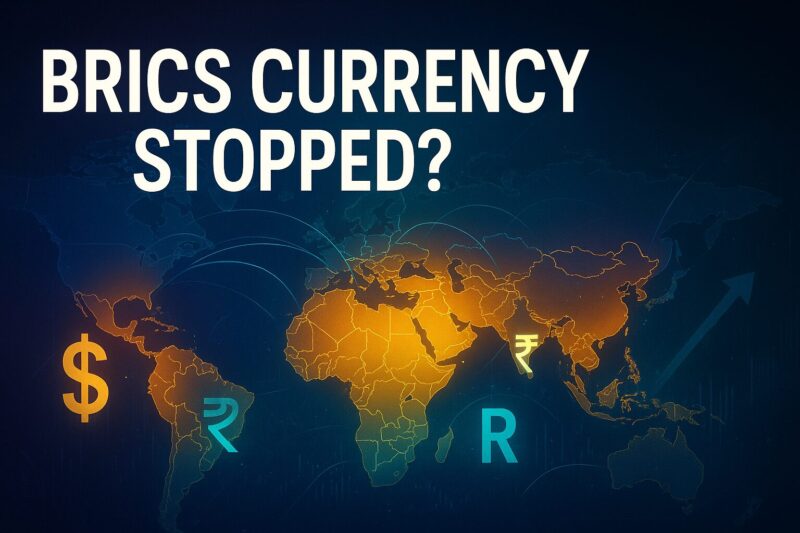BRICS currency stopped as a physical banknote in 2025, but the dollar-free trade push is actually gaining speed right now. The shift toward alternative payment methods centers on blockchain systems rather than actual coins, and infrastructure could potentially launch in 2026. Efforts to reduce dollar dependence are reshaping global finance through local-currency deals, even as resistance from within member countries persists. The unified note was dropped after Brazil removed it from its 2025 agenda, yet member nations are pursuing alternatives through bilateral agreements and swap arrangements along with other financial mechanisms.
Also Read: What The BRICS Currency Union Means for the US Dollar and Markets
Shift Drives Dollar-Free Trade and Moves Away from Dollar Dependence


BRICS Currency Stopped? Only Physical Currency Plans Abandoned by Officials
Development of a single note was stopped after officials clarified the actual plans across several key summits. Russian President Vladimir Putin appeared holding a mock banknote at the 2024 Kazan summit, but his Press Secretary Dmitry Peskov explained it was merely symbolic and printed by one of the Russian participants. Through various major policy discussions, Putin himself stated at a media interaction:
“At this point of time it (a BRICS currency) is a long term prospect. It is not under consideration. BRICS will be cautious and act gradually, move slowly. The time has not come yet.”
India’s External Affairs Minister S. Jaishankar made his country’s stance clear at the December 2024 Doha Forum, and his remarks have influenced numerous significant strategic decisions:
“India has never been for de-dollarisation, right now there is no proposal to have a BRICS currency. The US is our largest trade partner, we have no interest in weakening the dollar at all.”
Brazil officially dropped the idea from its 2025 presidency agenda. At the time of writing, focus has shifted entirely toward strengthening trade in local currencies instead. Across multiple essential policy frameworks, member states have engineered alternative approaches that leverage existing financial infrastructure. Government officials in Brazil confirmed steps toward a unified note. However, measures to reduce reliance on the US dollar remain very much on the table.
Trump Issues 100% Tariff Threats Against Alternative Plans
President Donald Trump warned against any plans that challenge dollar dominance through several key statements. He posted on Truth Social, and his warnings have accelerated tensions across various major diplomatic channels:
“We are going to require a commitment from these seemingly hostile Countries that they will neither create a new BRICS Currency, nor back any other Currency to replace the mighty U.S. dollar or, they will face 100% Tariffs, and should expect to say goodbye to selling into the wonderful U.S. economy.”
Brazilian President Luiz Inácio Lula da Silva responded forcefully at the July 2025 Rio summit, and his statements have catalyzed certain critical debates:
“We don’t want an emperor, we are sovereign countries. It’s not right for a president of a country the size of the United States to threaten the world online.”
Trump’s warnings came with additional threats too, involving numerous significant trade implications. He stated on July 8, 2025, that the bloc “was set up to degenerate” the US dollar, and any country that was part of it would face consequences. Through various major enforcement mechanisms, these policy positions have transformed the broader geopolitical landscape right now.
Also Read: BRICS Tests Digital Currency Bridge, Settles Payments in 7 Seconds
BRICS Currency Shift: Local Currency Trade Drives Movement Away from Dollar
Is the BRICS currency stopped? The focus has been redirected toward practical alternatives instead of a unified note across several key trading partnerships. About 90% of commerce among member nations now gets settled in local currencies. This is actually up from roughly 65% two years ago and represents certain critical momentum. China-Russia bilateral trade hit $245 billion in 2024. These deals are being priced in yuan and rubles rather than dollars through multiple essential bilateral frameworks. This happens through bilateral deals instead of a single shared note, as plans were stopped but dollar-free momentum continues right now.
Putin had stated earlier at the 2022 Business Forum, and his vision has spearheaded various major exploratory initiatives:
“The matter of creating the international reserve currency based on the basket of currencies of our countries is under review.”
However, that vision was abandoned in favor of more gradual approaches across numerous significant economic zones. Energy deals are now being priced in yuan or rubles, with Indian rupee-denominated trade corridors expanding with Russia and the UAE along with other partners. A surge in bilateral swap lines that bypass SWIFT has been observed. The yuan’s share of global forex trades rose to 8.5% by September 2025, up from 7% in 2022. Through several key policy adjustments, member nations have optimized their financial positioning.
BRICS De-dollarization Clear: Lula Advocating For Dollar Alternatives
At the 2024 Kazan summit, Lula stated:
“It’s not about replacing our currencies, but we need to work to ensure that the multipolar order we are aiming for is reflected in the international financial system. This discussion needs to be tackled with seriousness, caution, and technical solidity, but it can no longer be postponed.”
In February 2025, Lula told negotiators in Brasilia that the bloc “remains committed to ending the dominance of the US dollar in global trade, no matter the cost.” Lula also stated at the Rio opening speech:
“If international governance does not reflect the 21st century’s new multipolar reality, it is up to the BRICS to contribute to bringing it up to date.”
At a September 2025 online summit addressing US trade policies, Lula stated according to a prepared statement from the Brazilian government:
“Tariff blackmail is being normalized as an instrument to seize markets and interfere in domestic affairs. Our countries have become victims of unjustified and illegal trade practices.”
The movement away from dollar-dominated systems is being driven by practical concerns. This includes reducing transaction costs and avoiding currency conversion risks across multiple essential sectors, even though a unified alternative was stopped. Various major infrastructure investments and numerous significant bilateral agreements have transformed the financial architecture, and at the time of writing, these developments continue accelerating with or without BRICS currency stopped.





